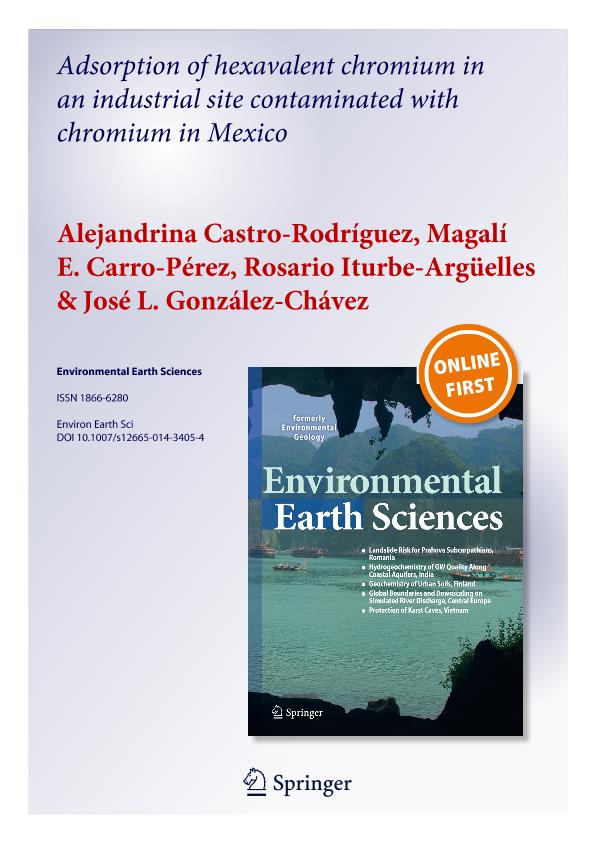Mostrar el registro sencillo del ítem
dc.contributor.author
Castro Rodríguez, Alejandrina
dc.contributor.author
Carro Pérez, Magalí Evelín

dc.contributor.author
Iturbe Argüelles, Rosario
dc.contributor.author
González Chávez, José L
dc.date.available
2018-01-22T15:12:03Z
dc.date.issued
2014-05
dc.identifier.citation
Castro Rodríguez, Alejandrina; Carro Pérez, Magalí Evelín; Iturbe Argüelles, Rosario; González Chávez, José L; Adsorption of hexavalent chromium in an industrial site contaminated with chromium in Mexico; Springer International Publishing AG; Environmental Earth Sciences; 73; 1; 5-2014; 175-183
dc.identifier.issn
1866-6280
dc.identifier.uri
http://hdl.handle.net/11336/34080
dc.description.abstract
This work presents the problems left by a company that manufactured chrome-plated products for 20 years, without controlling its waste, until it was closed by the authorities in 1978. The raw material used was chromite (FeCr2O4). The presence of chromium in the groundwater has been observed in recent years. Hence, there is a need to understand the adsorption capacity of the soils and to explain the presence of chromium in the groundwater. The soils at the site are sandy silts with a minor presence of clay and fine sands, which would lead to an initial expectation of high adsorption. We analyzed the adsorption capacity of hexavalent chromium (CrVI+) in the soils based on adsorption isotherms, determined the charge of the soil particles, and evaluated Gibbs free energy. The adsorption capacity was evaluated for three soil samples (S1, S2, and S3), obtained from the core of a well drilled in 2009, at the site where the manufacturing plant was located and at two more sites within its radius of influence, in the direction of the underground water flow to ascertain that the chromium adsorption data obtained are representative for the aims of the study. Concentrations of total Cr and CrVI+ were analyzed throughout the core of the drilled wells, as well as the soil mass contained therein. The average concentration of total Cr was 43.5 mg/kg, with a total mass of 21.1 g; whereas for CrVI+, the average concentration was 4.37 mg/kg with a mass of 2.12 g. A rough estimate with these values indicates that in the affected area (16,000 m2) and at a depth of 65 m, where the current groundwater level starts, there will be 18.53 tons of total Cr and 1.86 tons of CrVI+. Adsorption isotherms were drawn and the linear, Freundlich, and Langmuir models applied; the Freundlich model was the best fit for two of the soils (S1 and S2), while for soil S3 it was the linear model. According to the values for the partition coefficient, K d, obtained, the three soils showed low adsorption values. The net surface charge for each of the soils was determined, observing that for a broad pH range the charge was negative, which contributed to the low sorption of hexavalent chromium in the soils. The average CrVI+ adsorbed was 0.34 mL/g. Although this value represents a very low adsorption, it is sufficient to reveal the presence of chromium, even after more than 30 years, in the soil particles, particularly considering the reduction of groundwater level, which implies that the zone where the saturated zone had been is currently not saturated, and that chromium remained adsorbed. Lastly, the AGº thermodynamic parameter was calculated for each soil. In all cases, the value for the Gibbs free energy was positive, reflecting that the processes are not spontaneous, which concurs with the low adsorption results.
dc.format
application/pdf
dc.language.iso
eng
dc.publisher
Springer International Publishing AG
dc.rights
info:eu-repo/semantics/openAccess
dc.rights.uri
https://creativecommons.org/licenses/by-nc-sa/2.5/ar/
dc.subject
Adsorption
dc.subject
Hexavalent Chromium
dc.subject
Contaminated Industrial Site
dc.subject.classification
Meteorología y Ciencias Atmosféricas

dc.subject.classification
Ciencias de la Tierra y relacionadas con el Medio Ambiente

dc.subject.classification
CIENCIAS NATURALES Y EXACTAS

dc.title
Adsorption of hexavalent chromium in an industrial site contaminated with chromium in Mexico
dc.type
info:eu-repo/semantics/article
dc.type
info:ar-repo/semantics/artículo
dc.type
info:eu-repo/semantics/publishedVersion
dc.date.updated
2018-01-22T14:16:00Z
dc.journal.volume
73
dc.journal.number
1
dc.journal.pagination
175-183
dc.journal.pais
Alemania

dc.journal.ciudad
Berlin
dc.description.fil
Fil: Castro Rodríguez, Alejandrina. Universidad Nacional Autónoma de México; México
dc.description.fil
Fil: Carro Pérez, Magalí Evelín. Consejo Nacional de Investigaciones Científicas y Técnicas; Argentina. Universidad Nacional de Córdoba; Argentina
dc.description.fil
Fil: Iturbe Argüelles, Rosario. Universidad Nacional Autónoma de México; México
dc.description.fil
Fil: González Chávez, José L. Universidad Nacional Autónoma de México; México
dc.journal.title
Environmental Earth Sciences
dc.relation.alternativeid
info:eu-repo/semantics/altIdentifier/doi/http://dx.doi.org/10.1007/s12665-014-3405-4
dc.relation.alternativeid
info:eu-repo/semantics/altIdentifier/url/https://link.springer.com/article/10.1007%2Fs12665-014-3405-4
Archivos asociados
